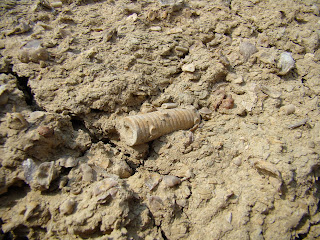Fossils aren't the first thing that comes to mind when people think of
Texas -
The Alamo (
Remember it?),
ten gallon hats and the ever-present longhorn probably all register first. But
Texas is full of fossils - so much so, that fossil hunters tend to make a dozen stops on their way to any other fossil destination.
Today, we stopped in
Mineral Wells, only two hours away from
Seymour (the town where we'll be digging for the rest of the week). Only a short car drive away, Mineral Wells represents a trip of several million years from our historical destination - the
Permian dirt that Seymour sits on.
Mineral Wells sits on sediments from the Pennsylvanian Epoch - which were covered by a shallow sea, like much of the rest of the state at the time. Imagine standing on today's streets, millions of years ago - as thousands of species of beautiful, multicolored
crinoids drift in the blue water around you, while insect-like
trilobites and other sea creatures swim or crawl right by. There were millions of them, and when they died, these spiny little guys floated to the ocean floor, were covered with sediment, and fossilized.
But their story didn't end there. 300 million years later, geologic forces are revealing them in many areas of Texas, including sites around the cities of
Jacksboro and Mineral Wells. Since we happened to be passing through, we decided to stop, take a look, and share a few fossils from the time period just before the Permian, where we'll be digging for the rest of the week.
 (Center) The tail (pygidium) of a tiny trilobite, ditomopyge sp., an extinct type of arthropod, lays amid fossils of various other sea creatures. Despite the fact that there are hundreds of known trilobite species, only one species has been found at this site. Why?
(Center) The tail (pygidium) of a tiny trilobite, ditomopyge sp., an extinct type of arthropod, lays amid fossils of various other sea creatures. Despite the fact that there are hundreds of known trilobite species, only one species has been found at this site. Why?
 The long tube in the lower center portion of this photo is the stem of a crinoid - a type of sea lily - shown eroding out of the sediment. In life, this would have been part of a very long stem, anchored to the sea floor or a rock. A flower-like appendage was attached to the top of the stem - but this was no flower. It was actually made of long arms that caught tiny prey as it floated by and moved it to the mouth at the flower's center.
The long tube in the lower center portion of this photo is the stem of a crinoid - a type of sea lily - shown eroding out of the sediment. In life, this would have been part of a very long stem, anchored to the sea floor or a rock. A flower-like appendage was attached to the top of the stem - but this was no flower. It was actually made of long arms that caught tiny prey as it floated by and moved it to the mouth at the flower's center.
These also tend to separate along the lines (or sutures) that are visible on the surface.

When pieces do separate from the original crinoid stem, they look like the discs in the photo above - quite pretty, actually. The tiny star in the center was part of the crinoid's stomach.
 There are only a very few brachiopods left in the world today - the half-circle, wavy item in this photo is a 300-million example of the spirifer genus. Many had a foot outside of the shell that anchored them to the sea floor.
There are only a very few brachiopods left in the world today - the half-circle, wavy item in this photo is a 300-million example of the spirifer genus. Many had a foot outside of the shell that anchored them to the sea floor.
 Of course, it wasn't all sea flowers and bivalves. Sharks have been stalking the Earth's shores for 400 million years, and the Pennsylvanian is no exception. Above, a very rare Petalodus shark tooth (brown and white), above a trilobite spine (gray), which would have protruded from the trilobite's head.
Of course, it wasn't all sea flowers and bivalves. Sharks have been stalking the Earth's shores for 400 million years, and the Pennsylvanian is no exception. Above, a very rare Petalodus shark tooth (brown and white), above a trilobite spine (gray), which would have protruded from the trilobite's head.
 And though you might think so, scrolling through today's pictures - the dig site is not all gray. Even heading into winter, there are wildflowers around.
And though you might think so, scrolling through today's pictures - the dig site is not all gray. Even heading into winter, there are wildflowers around.
If you'd like to see some of these specimens up close, check out Dino BONE-anza, a family fossil festival on Nov. 17 at The Woodlands Xploration Station (an HMNS satellite facility). Lots of similar specimens were gathered today to talk about and give away at this event.
That's it for our foray into the Pennsylvanian. Starting Monday - it's all Permian, all the time.







6 comments:
sweet quotes | kids songs | colleges in calgary
home moving | art classes nyc | light fixtures
laser hair removal austin tx | bedroom mirror | Whitby homes
exterior patio doors | ged | front doors
Surely, the guy is totally just.
site
Pretty worthwhile piece of writing, much thanks for the post.
Concerning the Brachiopods that were mentioned, Spirifer is not a genus but an order of Brachiopods, there are at least 30 genera under the Spririferida order. Also not some but all Brachiopods were anchored to the sea floor by a muscle from the back of their shell that is called the peduncle. The Brachiopods and any Bryozoans that you may find here are all part of the Lophophoridae phylum. I hope this is helpful.
It won't truly have success, I believe this way.
san diego mattress | Staffing Agencies In Dallas TX | budget truck rental discount codes
Were these photos of the matrix with fossils taken at mineral wells? I have not seen that many there. And, when I did find some fossils, there were very small. But, certainly not in that great a number. Thanks!
Post a Comment